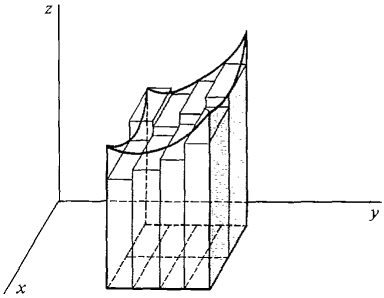| The ebook Elementary Calculus is based on material originally written by H.J. Keisler. For more information please read the copyright pages. |

|

Home  Multiple Integrals Multiple Integrals  Double Integrals Double Integrals  Double Riemann Sum - Rectangular Region Double Riemann Sum - Rectangular Region |
|






|
|
Double Riemann Sum - Rectangular Region
We now define the double Riemann sum and use it to give a precise definition of the double integral. We first consider the case where D is a rectangle a1 ≤ x ≤ a2- b1 ≤ y ≤ b2, shown in Figure 12.1.5.
Figure 12.1.5 Let Δx and Δy be positive real numbers. We partition the interval [a1,a2] into subintervals of length Δx and [b1, b2] into subintervals of length Δy The partition points are x0 = a1, x1 = a1 + Δx, x2 = a1+ 2 Δx,..., xn = a1 + n Δx, y0 = b1, y1 = b1 + Δy, y2 = b1+ 2 Δy,..., yp = b1 + p Δy where xn, < a2 ≤ xn, + Δx, yp < b2 ≤ yp + Δy.
If Δx and Δy do not evenly divide a2 - a1 and b2 - b1,there will be little pieces left over at the end. We have partitioned the rectangle D into Δx by Δy sub-rectangles with partition points (xk , yl), 0 ≤ k ≤ n, 0 ≤ l ≤ p, as in Figure 12.1.6.
Figure 12.1.6 The Double Riemann Sum for a rectangle D is the sum
This is the sum of the volume of the rectangular solids with base Δx Δy and height f(xk,yl). As we can see from Figure 12.1.7,
approximates the volume of the solid over D between z = 0 and z = f(x, y).
Figure 12.1.7 Double Riemann Sum
|
|
Home  Multiple Integrals Multiple Integrals  Double Integrals Double Integrals  Double Riemann Sum - Rectangular Region Double Riemann Sum - Rectangular Region |
|
Last Update: 2010-11-25






